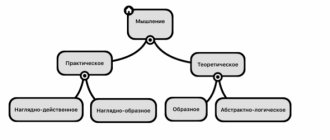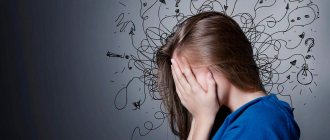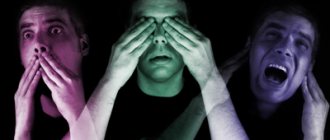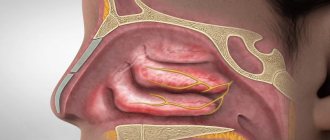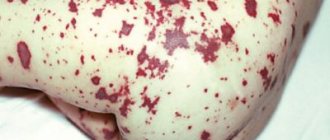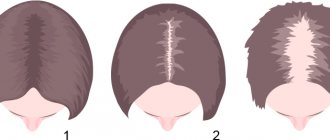It is difficult for any parent to imagine that their child may be susceptible to any mental illness.
However, unfortunately, recently, a disease such as schizophrenia in adolescents is being diagnosed more and more often. At the initial stage of development it is very difficult to establish the correct diagnosis, so it progresses quickly. And this is truly scary.
Here is a far from complete list of questions that concern parents who have noticed something strange in their child’s behavior:
- What is the cause of the development of mental disorders in children?
- What you need to know about the first signs of teenage schizophrenia?
- How to recognize a mental disorder in a child’s changeable behavior?
- How to properly diagnose and treat this disease?
- Is it possible to get rid of schizophrenia forever?
- Is there a possibility that mental disorders will go away along with adolescence?
There are answers to these questions.
Causes
The exact cause of the development of schizophrenia in adolescence is not known for certain. However, we can confidently say that there are factors that have a direct impact on the formation of the disease. These include:
- hereditary predisposition;
- stressful situations;
- complex family relationships;
- computer addiction;
- drug use;
- smoking, childhood alcoholism.
Through many years of research, it has been proven that a teenage child is twice as likely to develop schizophrenia if this disease was previously detected in one of his relatives. The likelihood of a mental disorder increases significantly if both parents suffer from schizophrenia. Heredity has a huge influence on the formation of personality traits.
Stress is known to be the cause of many diseases, and schizophrenia is no exception. Excessive experiences, combined with the unformed psyche of a teenager, form the basis of first emotional disruptions and then severe psychoses. And they already entail schizophrenic disorders.
A turbulent situation in the family, conflicts with parents, youthful maximalism - all these are attributes of adolescence. They may well become the impetus for the development of the disease. A teenager who does not find support and understanding for a long time loses self-esteem, withdraws into himself and becomes depressed. You cannot do without the help of a psychotherapist in such a situation.
Excessive passion for computer games is the scourge of our time. What does schizophrenia have to do with it? It's simple. During the game, the perception of real events occurs. The more a teenager is attracted to the computer, the thinner the line between the real and virtual world. The understanding of all life events changes dramatically. Hallucinations and delusions are perceived as part of the game, and the child has no desire to leave it. Parents do not see anything unusual in the fact that he is talking to himself, but it is at this moment that they need to start sounding the alarm.
Drugs, alcohol and cigarettes in themselves are unacceptable things for a teenager. They have a negative impact on the physical condition of a still fragile child’s body, leading to general intoxication and mental retardation. But the worst thing is that the brain cells suffer from this. An incompletely formed psyche under the influence of narcotic substances can provoke a malfunction leading to schizophrenia and other severe disorders of consciousness.
Manifestations of the disease
Unfortunately, there are no symptoms that can be detected to clearly indicate that a teenager is developing schizophrenia. Each case is individual. It would seem that similar manifestations in one child may indicate a serious illness, while in another it is just character traits, gaps in upbringing, or simply a bad mood.
The main signs of schizophrenia are of three types:
- Negative. They represent disorders of the psyche and some body functions. Certain emotions simply become inaccessible to a teenager. He loses the ability to think logically, plan his actions, and take responsibility for his own actions. From the outside, this may look like aloofness, isolation, or simple laziness. These symptoms are quite difficult to identify and correctly qualify.
- Positive. In fact, there is nothing good, much less positive, about them. Symptoms have this definition because they are acquired by the body as the disease progresses. These include hallucinations and delusions.
- Cognitive. They manifest themselves as a failure of mental functions, apathy and indifference. Concentration and the ability to remember and use information suffer. These violations are difficult not to notice during close contact with the child.
At the initial stage, the teenager perceives hallucinations simply as his overdeveloped fantasy. Moreover, they can be visual or auditory, or combined with each other. Only over time does the child realize that something is wrong with him. The situation is complicated by the fact that the psyche is not yet fully formed, so it is impossible to predict the consequences of schizophrenic attacks.
During the period of exacerbation, the teenager loses his sense of reality. He is confused and depressed, there is no sense of social balance. The mood can change sharply and unpredictably, emotions do not always correspond to the situation. Progressive schizophrenia does not allow active communication with others - there is autism, unsociability and apathy.
By withdrawing into himself, the child is left alone with the problem. Typical situation of the initial stage of schizophrenia:
- a teenager hears some voices in his head;
- sometimes it seems to him that they are reading his own thoughts out loud;
- he is visited by various visions;
- there is a feeling of being watched or followed.
But the worst thing is that the child cannot tell anyone about this: the parents are too busy with work or themselves, friends will most likely perceive such a story as another reason for ridicule and bullying. Therefore, there is nothing left to do but fight your own fears alone.
And only when the symptoms of schizophrenia get out of control does it become impossible to hide the disease. If this happens, you should immediately contact a specialist. Undiagnosed mental disorders in adolescence can have very dire consequences.
It is worth noting that in most cases, schizophrenia in adolescents distorts emotional perception or develops dysfunction of thinking and perception of information. But, at the same time, surprisingly, the disease does not affect intellectual abilities. That is, visible changes occur in the child’s behavior, but if he studied well at school, he continues to do so.
Symptomatic psychoses
6.1. Symptomatic psychoses
This refers to transient psychotic disorders due to general infections, intoxications and non-infectious somatic diseases. Rudimentary symptomatic psychotic psychoses in children are much more common than in adults, while developed and especially protracted symptomatic psychoses in childhood are relatively rare (Kovalev V.V., 1979). Abortive symptomatic psychoses occur in children mainly during febrile states, especially during general infections or toxic infections (febrile psychoses, according to E. Kraepelin, 1927).
Psychosis is usually preceded by a short prodromal period (up to 2–3 days). In cases of less pronounced toxicosis and moderate hyperthermia, children of preschool and primary school age may report malaise (they “feel bad”), headaches, and discomfort in other areas of the body. They lose their characteristic cheerfulness, inexhaustible activity, become capricious, whiny, refuse to eat, and lose interest in the game. Older children and adolescents often exhibit depressed mood, anxiety, sensory hyperesthesia, and may have concerns about their health associated with somatovegetative dysfunction. With a more severe course of the disease, lethargy, lethargy, silence, and severe mental exhaustion are more often detected, and the prodromal period is reduced.
The psychotic state lasts from several hours to 2–3 days. The most typical are states of stunned consciousness (from oblivion to somnolence, less often stupor), which are interrupted by short-term episodes of delirium or pre-delirium. Stupefaction of consciousness is characterized by blurred perception, impoverished content of consciousness, slow course of mental processes, emotional indifference, fluctuations in clarity of consciousness, and drowsiness.
Delirious episodes are characterized by anxiety, fear, and optical illusions, especially pareidolia. Visual hypnagogic hallucinations often occur, often of ordinary content (people, animals, scenes from school life are seen). Much less frequently and, as a rule, in children 9–10 years of age and adolescents, extensive visual hallucinations occur at night with content typical of delirium, often of a frightening nature (animals, birds, etc.). Elementary auditory deceptions (noise, whistling, etc.), calls by name, and unclear voices of “familiar guys” may occur.
In intoxication psychoses (poisoning with henbane, atropine, atropine-containing drugs, cyclodol), more abundant and vivid visual hallucinations (numerous small animals, insects) are observed. During delirium, patients are excited, talkative, and their behavior reflects the content of visual illusions. Episodes of delirium are usually short-lived (no more than 2–3 hours) and may recur, usually in the evening and at night. Dyssomnia is detected (disturbance of the sleep-wake cycle, alternation of drowsiness and insomnia), and symptoms of autometamorphopsia often occur (“swollen fingers”, etc.).
Recovery from a psychotic state with a predominance of delirious disorders is usually critical, sometimes asthenic phenomena persist for some time (increased fatigue, tearfulness, mood swings, etc.). Congrade amnesia is detected, especially during periods of stunned consciousness. In this case, amnesia extends primarily to real impressions, while memories of deceptions of perception can be quite complete.
In childhood, in contrast to older adolescents, productive psychopathological symptoms are usually rudimentary and are represented by fragmentary illusions and deceptions of perception; emotional disturbances - fear, anxiety, and restlessness - come to the fore. The younger the child is, the greater the proportion of deafness in psychosis. The predominance of stunning in older children indicates the severity of psychosis, especially if states of stupor occur.
As the disease progresses and cerebral edema develops, patients fall into a comatose state of varying depths, up to depression of vital functions and death. The presence of stupor and coma in children under 5 years of age is associated with greater sensitivity of the brain to toxic-infectious agents and has a more favorable prognosis than in older children, and even more so in adults. Nevertheless, upon recovery from psychosis, young children retain an asthenic state for a long time, and sometimes symptoms of regression (temporary loss of certain skills and abilities) are revealed.
In cases of protracted infectious and infectious-allergic diseases with less toxicosis (malaria, rheumatism, viral pneumonia), as well as in the immediate post-infectious period after influenza, scarlet fever, the picture of symptomatic psychoses is significantly transformed, approaching the manifestations of exogenous-organic psychoses and “late symptomatic psychoses” "(Snezhnevsky A.V., 1940). In this case, along with stunned consciousness and delirium, oneiric and amentive states may occur.
Oneiric states are usually short-lived (up to several hours) and are manifested by exciting dreams of fantastic content: scenes reminiscent of the plots of science fiction books or films are perceived, at which time the patient seems to transform into their characters, losing consciousness of his own identity. In the assumed virtual role, he can be active, perform some actions, but outwardly most often he becomes sedentary and even freezes in certain poses, his gaze is fascinated and is not fixed on real objects. He also perceives the surrounding people and the situation as some kind of enchanting phenomena, while he makes or does not make contact well, loses the ability to orient himself in reality and in time, or, more often, orientation can be double. For example, a doctor is perceived both as a doctor and at the same time as a character in the patient’s dreams, for example, an inhabitant of the other world (“oriented oneiroid”).
The content of dreams corresponds to the patient's mood. If the mood is depressed, then the dreams acquire a gloomy, sometimes otherworldly content; if it is elevated, delightful scenes are perceived, and an enthusiastic, ecstatic state develops. The depth of stupefaction constantly fluctuates, the patient either disappears from reality or returns back. The oneiric state usually alternates with phenomena of stunning consciousness, and sometimes delirious episodes occur, which, like stunning, indicates a worsening of the condition.
The presence of catatonic symptoms (stupor, mutism) or, on the contrary, psychomotor agitation with stereotypies, impulsive actions, presumably indicates the transition of symptomatic psychosis to exogenous-organic.
Upon recovery from psychosis, patients can talk about oneiric experiences in sufficient detail and, as a rule, cannot report anything about real impressions.
Much less often and mainly with long-term debilitating toxic infections in older children and adolescents, amental states may occur. Severe states of amentia are rare. They are characterized by chaotic mental processes, incoherence of thinking, speech and emotional manifestations, uncoordinated motor arousal (yactation - agitation within the bed). Sometimes fragmentary deceptions of perception and catatonic symptoms may be detected. Patients are not available for contact, and only in isolated cases and for a short time do they come into contact. In cases of mild amentia, patients answer questions correctly for some time, but as neuropsychic exhaustion increases, their speech becomes more and more incoherent - asthenic confusion (Mnukhin S.S., 1963). The duration of amental darkness can reach several weeks. Upon recovery from psychosis, pronounced asthenia is noted with rapid exhaustion, lethargy, irritability, impressionability, sensory hyperesthesia, gloomy mood - emotional-hyperesthetic weakness, according to K. Bonhoeffer (1910).
With prolonged symptomatic psychoses (post-infectious psychoses), endomorphic psychopathological syndromes may occur in children and adolescents: depressive, anxious-depressive, depressive-hypochondriacal, hypo- and manic, rudimentary depressive-paranoid (Kovalev V.V., 1979). In particular, they are described in malarial and malarial-acryquin psychoses. In post-infectious influenza psychoses, a transient amnestic syndrome has also been described (Sukhareva G.E., 1974). Depressive states are more common, in some cases including episodic visual and auditory deceptions of perception, fragmentary delusions of relationships, and persecution. As a rule, this reveals pronounced asthenic symptoms. The duration of such psychoses sometimes reaches 2–3 months. Unlike schizophrenia, in addition to asthenia, such psychoses usually occur following episodes of confusion and are accompanied by various somatic disorders, increased body temperature, inflammatory changes in the blood, and often increased cerebrospinal fluid pressure.
Does the child have symptomatic psychosis? We will help you! Call us
Return to Contents
Determining the diagnosis
Analyzing visible and hidden symptoms and making an accurate conclusion is already a big step towards getting rid of the disease. An incorrect diagnosis leads to incorrect treatment. As a result, instead of recovery, the disease drags on and progresses, and it becomes much more difficult to cope with it.
Some people generally refuse to recognize schizophrenia in adolescents as a disease. They associate unusual behavior with:
- lack of vitamins and microelements in the body;
- metabolic disorders;
- general fatigue;
- characteristics of the personality's psychotype;
- influence of external factors.
However, schizophrenia exists, and it begins in adolescence. The slightest deviation in a child’s behavior should be a reason to contact a psychiatrist.
To identify the diagnosis, the child is monitored for at least six months. There is no way to do this before, since the symptoms and course of the disease may change.
To exclude tumors and other brain diseases, it is necessary to conduct the following studies:
- Magnetic resonance imaging;
- electroencephalography;
- general and biochemical blood test;
- state of immune status;
- assessment of hormonal levels.
Specially designed psychological tests play a major role in diagnosing schizophrenia in adolescent children. With their help, you can determine which brain structure is most affected by the disease. Information provided by parents and other relatives who have close contact with the patient is also taken into account.
Suicidal behavior
And one of the fairly common fatal consequences of these personality disorders in adolescence, or psychopathy, as we also call them differently, is suicidal behavior
, aimed not only at leaving life, but also at causing harm to oneself.
This is the so-called self-destructive behavior or non-suicidal self-destruction, when a teenager begins to punish himself with quite serious burns, self-cutting and some other self-harm.
When he embarks on a very slippery criminal road, when, unfortunately, at this age, he develops addictions, both alcohol and psychoactive substances.
When he becomes a gambling addict, he hangs up on the computer, when he disappears, he leaves home in this state of protest to his relatives.
Or when he develops various kinds of somatoform, psychosomatic disorders in the form of a huge number of health complaints that are not confirmed by somatic or neurological examinations.
Treatment
There are cases when, suspecting something was wrong in the actions of a teenager, parents or teachers took him to a psychologist. The responsibilities of this specialist include monitoring the patient’s behavior, identifying his psychotype, etc. However, he will not be able to determine schizophrenic disorder. Only a psychiatrist will do this; he will also prescribe treatment.
So is it possible for a teenager to completely get rid of schizophrenia? Yes, this is possible, but not a single psychotherapist can guarantee that this will happen in any particular case. With the right treatment, long periods of remission may occur after the condition worsens.
Acute symptoms of schizophrenia are relieved with antipsychotics. This happens in a hospital, under the constant supervision of specialists. To achieve visible results, you need to take the medications prescribed by your doctor for at least three weeks. The following may be prescribed as auxiliary means:
- antidepressants;
- tranquilizers;
- antipsychotic substances.
The length of hospitalization depends on the severity of symptoms and the general condition of the adolescent. Therapy gives lasting positive dynamics. After completing an intensive course of treatment, the patient is sent home for further rehabilitation on an outpatient basis and social adaptation.
Life after confirmation of illness
Yes, it exists.
It often happens that a timely diagnosis allows you to stop the progression of the disease. In this case, the teenager may not remember his illness for the rest of his life. But not everyone is so lucky. It happens that teenage schizophrenia does not go away without a trace, but simply transforms into another stage, then you need to learn to live with it. Of course, it won’t be easy to do this, but you shouldn’t despair and give up: people live with much more serious problems. Even if the diagnosis of schizophrenia is finally confirmed, this is not a reason to despair and give up. It is very important to start treatment, and modern medications truly work wonders and have virtually no side effects.
Nowadays, schizophrenia is not a death sentence at all; a young person should and can lead a normal life. Periods of remission can last up to 5-7 years.
There is an opinion that schizophrenia, which began its development in adolescence, must necessarily manifest itself in aggressive behavior or shocking actions. In reality, everything is not like that. Schizophrenic attacks do not provoke aggression. A teenager suffering from this mental disorder is more likely to harm himself than someone else around him.
After treatment, the child must undergo a rehabilitation course. She will prepare him for life in society. Experts will tell you how to behave in various situations, analyze feelings, and control emotions. In some cases, a teenager will need constant monitoring.
Features of adolescence
Teenager
- this is a person whose emotions are extremely mobile and are not retained for a long time; unfortunately, they can be quite superficial and shallow.
During adolescence, a person experiences a large number of revelations and discoveries. The experience of betrayal is especially difficult for him; adolescents have a very acute and slightly exaggerated attitude towards such important concepts for them at this age as friendship and love. And breaks in friendships and love relationships in adolescence are perceived as mental trauma, quite severe, sometimes catastrophic.
At this age, which is also called puberty
, we psychiatrists quite often encounter the onset of certain mental disorders.
The importance of family support
Of course, it is important that a teenager knows that there is a person next to him whom he can turn to and tell about all his fears and experiences. Then the likelihood increases that schizophrenia will be identified at the initial stage and treatment will give maximum results. But this rule only works if the patient’s relatives adequately assess the seriousness of the mental disorder and are aware of the possible consequences.
It often happens that caring mothers and fathers, instead of taking their child to see a psychiatrist as soon as possible, find all sorts of excuses for his strange behavior. For example:
- incoherent muttering, an unblinking gaze at one point is explained by the fact that the child has been over-studying and is collapsing from fatigue;
- hallucinations - the consequences of too strong expression of emotions;
- reluctance to communicate with peers - excessive workload at school;
- despondency and indifference are just a bad mood.
With blind love mixed with pity for their loved one, parents themselves aggravate the situation. By not contacting a specialist in time, they delay the recovery process. The slightest psychological trauma can lead to the initiation of the disease, not become its cause, but only contribute to the development of symptoms.
A feature of schizophrenic disorder is a tendency toward suicidal behavior or self-harm. In this regard, there is an urgent need for constant monitoring of the teenager.
In addition, it is advisable to find an activity that he will like and generally adjust his lifestyle. Please pay attention to:
- proper and healthy nutrition;
- playing sports;
- intellectual development;
- leisure.
Relatives of a child with schizophrenia should know for themselves that it can and should be treated and convince the patient of this. A visit to a psychiatrist cannot be avoided, but it is not at all as scary as is commonly believed.

